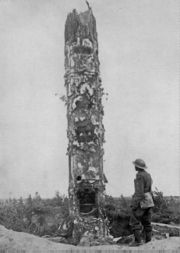Military tactics
| Warfare |
|---|
|
Eras
Prehistoric
Ancient Medieval Gunpowder Industrial Modern Battlespace
Tactics
Attrition warfare
Guerrilla warfare Maneuver warfare Siege Total war Trench warfare Conventional warfare Unconventional warfare Asymmetric warfare Counter-insurgency Network-centric warfare Cold war Proxy war Economic
Grand Operational Logistics
Technology and equipment
Materiel Supply chain management Lists
|
| Portal |
Military tactics, the art of organizing an army, are the techniques for using weapons or military units in combination for engaging and defeating an enemy in battle.[1] Changes in philosophy and technology over time have been reflected in changes to military tactics.
Contents |
Concept
Before the nineteenth century, many military tactics were confined to battlefield concerns, such as how to best maneuver units during combat in open terrain. In current military thought, tactics are the lowest level of planning, involving small units ranging from a few dozen to a few hundred personnel.
Units are organized into formations, comprising a higher level of planning known as the operational use of forces. The third tier of military planning is strategic, which is concerned with the overall means and plan for achieving a long-term outcome. Operational warfare is thus an intermediate level in which the aim is to convert the strategy (highest level) into tactics (lowest level of planning).
Specialized tactics exist for many situations, ranging from securing a room or individual building, to large-scale operations such as establishing air superiority over a region. Today, military tactics are employed at all levels of command, from individual and group, up to entire armed forces.
Indeed, the units used in warfare have always been a reflection of current military tactics, and their size and composition have varied accordingly.
Most people, including some people who are otherwise well-acquainted with military vocabulary, incorrectly use the words "strategy" and "tactics" more or less interchangeably.

Military tactics are at once both a science and an art. There are basic principles which -- if followed -- at least lend competency, 'battle drills' which try to promote automatic responses to given situations, and dozens of guides and instructions that have been written over the centuries.
For some, tactics are instinctive. Sometimes they can be taught. At its heart, tactics is a shifting amalgam of psychology, physics, and statistics.
Some practices have not changed since the dawn of warfare: Ambushes, seeking and turning flanks, maintaining reconnaissance, creating and using obstacles and defences, etc. Using ground to best advantage has not changed much either. Heights, rivers, swamps, passes, choke points, and natural cover, can all be used in multiple ways.
What does change constantly is the technological dimension, as well as the sociology of combatants. One might wish to reflect on the differences in the technology and society that produced such different types of soldier or warrior as the Roman Legionary, Mongol Horse Archer, the Chinese Crossbowman, the British Redcoat, or an Air Cavalry trooper.
Each, constrained by his weaponry, logistics and his social conditioning, would use a battlefield differently, but would usually seek the same outcomes from their use of tactics.
References
Notes
- ↑ (Carl *Clausewitz: On War, 1832))
Bibliography
- Rob Johnson and Michael Whitby, How to Win on the Battlefield: The 25 Key Tactics of All Time (2010)
- Muhm, Gerhard. "German Tactics in the Italian Campaign". http://www.larchivio.org/xoom/gerhardmuhm2.htm.
- Gerhard Muhm : La Tattica nella campagna d’Italia, in LINEA GOTICA AVAMPOSTO DEI BALCANI, (Hrsg.) Amedeo Montemaggi - Edizioni Civitas, Roma 1993
External links
- Contemporary Marine tactics for war fighting
- Napoleon's tactics and strategy
- Small Unit Actions during German Campaign in Russia
See also
- Firewalker (film) (1986)
- The Dirty Dozen (1967)
- Jarhead (film) (2005)
- In the Line of Fire (1993)
- Heartbreak Ridge (1986)
